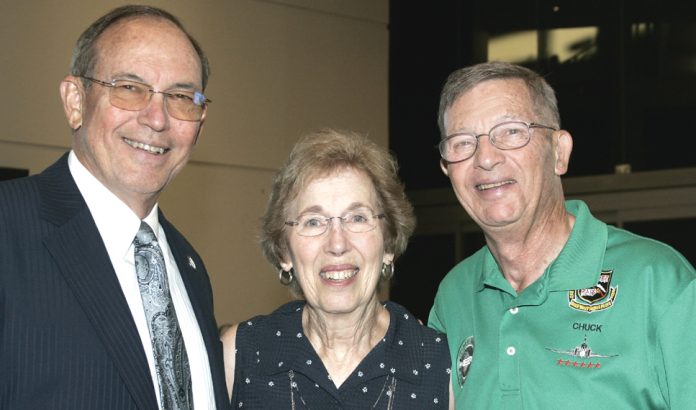
Story and photos by Darl DeVault, Contributing Editor
Locally the U.S. Air Force’s 75th-Anniversary celebration took place September 8 at the Oklahoma History Center featuring America’s leading Vietnam War Ace, Edmond’s retired Col. Chuck DeBellevue, who gave a narrative of his eventful missions.
The Air and Space Forces Association Gerrity Chapter #215, the Oklahoma Aeronautics Commission, and the Oklahoma Defense Industrial Association organized the event to celebrate America’s dominance of the skies in armed combat.
To sustain an enduring advantage in its trailblazing 75-year history, the U.S. Air Force’s place as the world’s most capable and respected source of airpower is well-established. The presentation clarified why the last time an American combatant was killed on the ground by an adversary air force was April 15, 1953.
Retired Air Force Lt. Gen. David Deptula, dean of the Mitchell Institute of Aerospace Power Studies, traveled from Washington, D.C., to moderate a discussion with DeBellevue on an educational panel wherein he recounted each of his six MiG kills in the skies of North Vietnam. The Mitchell Institute is the only aerospace power-focused think tank in the nation.
Edmond’s DeBellevue, 77, is America’s last ace to serve on active duty. In the Vietnam War he was a weapons systems officer (WSO) in the F-4 Phantom II fighter. Following his combat tour, DeBellevue attended pilot training and returned to the F-4. During the interview, he credited the real-time support of many people, from crew chiefs and maintainers to cooks and supply guys, for making the F4 effective in battle. While explaining each MiG kill, he said he was a part of an air combat crew with a real team spirit of agile thinking, persistence, and a certain disregard for the rules. DeBellevue commented, “The team that flew with us into Hanoi on a daily basis were all focused on the mission. You had to know we were going to get everyone home. If you had doubts or didn’t feel good about the mission, not only would you not go with us, but we would not take you.”
In 1972, Hanoi, the capital of North Vietnam, was the most heavily defended city in the world except Moscow, with the thickest air defense system that surface-to-air missiles (SAM), antiaircraft artillery (AAA), and interdiction MiGs could provide.
Early in the presentation, DeBellevue’s wife, Sally, was recognized in the audience. DeBellevue explained that in 1972 the communications between him and his wife were by letter, so she got a letter every day that stated, “I was alive last week,” knowing the time required for the letter to get to her.
The audience was comprised of 200 veterans and their wives and families, active duty and reserve service members, legislators, and defense and aerospace industry representatives.
The event also marked DeBellevue’s 50th year to the day he became America’s leading Vietnam War ace. In 1972, DeBellevue became one of only five Americans to achieve flying ace status and the first as a WSO, an integral part of two-person aircrews, with the emergence of air-to-air missiles as the primary weapons during aerial combat. He was credited with a total of six MiG kills, the most earned by any U.S. aviator during the Vietnam War and is a recipient of the Air Force Cross and three Silver Stars.
“A large part of the team did not fly into combat but were so vitally important to the success of the missions we flew,” DeBellevue said. “From getting the jets ready to ensuring the bombs and missiles were loaded and ready, to the electronic techs that kept the systems peaked, to the supply teams who kept the parts and fuel coming to the base, the support troops and, of course, the cook who had breakfast ready at 4:30 every morning, the team worked well together. They all put the confidence in the jet that allowed me to take it into North Vietnam every day and to know it was ready for whatever happened.”
Deptula retired in 2010 after 34 years of service, where—among other accomplishments—he was the principal attack planner for the Desert Storm air campaign in 1991, commander of no-fly zone operations over Iraq, where he flew 82 combat missions as a general officer. He planned and orchestrated air operations over Afghanistan in 2001 in response to the 911 attacks.
Deptula observed DeBellevue’s achievement in an interview, “We all know him as America’s top ace of the Vietnam War and the last ace to serve on active duty in the United States Air Force. But there’s a lot more to Chuck—excellence, teamwork, and dedication to duty are themes that resonate throughout his life. History books may celebrate him for his MiG kills, but what we are here to celebrate is a lifetime of service.”
After the one-hour presentation, AAR, Boeing, Captain Bob Ford, the Air Warrior Courage Foundation, and the Retail Liquor Association of Oklahoma sponsored a defense and aerospace industry reception.














